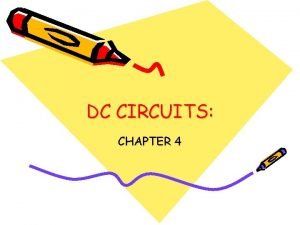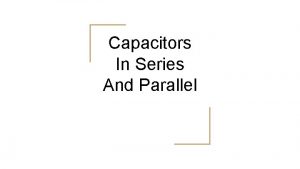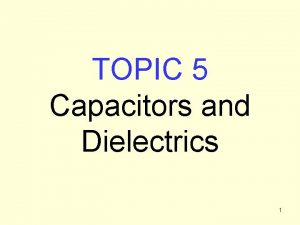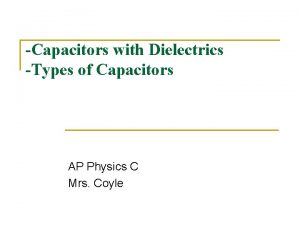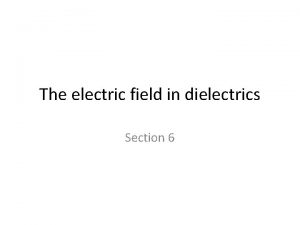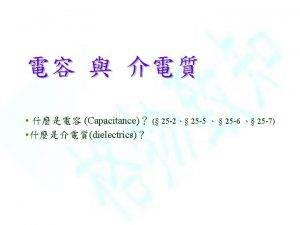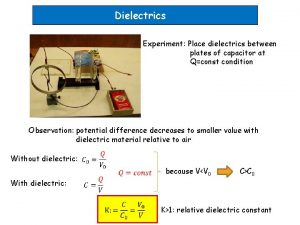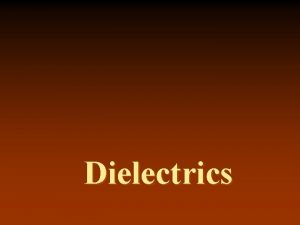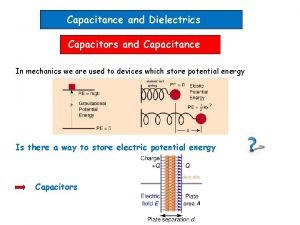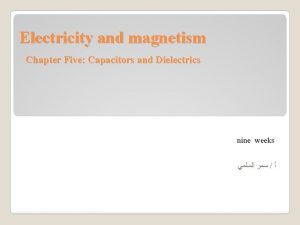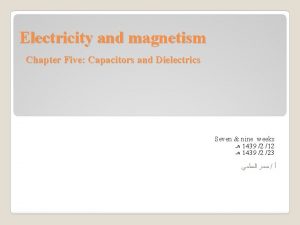Capacitors and Dielectrics And you Recall that In











- Slides: 11

Capacitors and Dielectrics And you

Recall that: • In an electric field, as a point charge moves, the amount of EPE changes. We define the change in EPE/charge (on the point charge) as VOLTAGE • There are different voltages in different regions of the electric field around a point charge Q

New Stuff: • A voltage difference can also exist between 2 charged conductors that are near to each other but not touching. • This arrangement is called a capacitor and it has the capacity to store electric charges + + + -

If you also: • Place an insulating material (dielectric) between the 2 conductors, you increase the capacity of the charge that can be stored. • The magnitude of the charge on a plate (conductor) is given the symbol q • q α V that is to say: q = CV C = a constant known as capacitance

The energy stored • Estored = ½ q. V = ½ CV 2 = q 2/ 2 C • NO time for derivations on this one – you will spend a good deal of time on this if you take an electrical engineering class in college. . .

The Battery • A number of capacitors in sequence is known as a “battery” • Although the term battery is used in a more general sense now.

The Lyden Jar Demonstrations • 1) Simple circuit: Feel the flow of charges Flow of charges = current (I) = charge/time = Δq/Δt = 1 columb/ 1 sec = Ampere (amps) • DC = direct current (moves in same direction) • AC = alternating current (changes directions)

• 2) Circuit with fiberglass insulator: Resistance (R) = voltage/current = V/I = Ohm’s law • 1 volt/ampere = Ohm (Ω) • That is to say, lg. V with small current = high resistance • In a wire: R = ρ (L/A) • ρ = resistivity of the material (Ω meters) • L = length, A = cross sectional area

Power • • • Power = change in energy / time interval P= (Δq)V / Δt Recall that (Δq) / Δt = current (I) Therefore: P = I V (current Voltage) Units of power are the Watt (W)

Voltage • As stated earlier: V = ΔEPE/qo = Work/qo = FIId/qo = qo. E d/qo = E d • Also keep in mind that ΔEPE = ΔKE • SO: Eqod = ½ mv 2 = q. V • NOTE: I use little v for velocity and big V for voltage here.

Summary • (I) = current (in amperes) = flow of charges • (V) = Volts = energy per charge • (Ω) = Resistance (in Ohms) = resistance to flow of current • (P) = power (in Joules/s = Watt) = current x voltage = (I)(V) • Now lets use this stuff in a lab so you understand it better!!!!
 Ngoại tâm thu thất chùm đôi
Ngoại tâm thu thất chùm đôi Block nhĩ thất độ 2 mobitz 1
Block nhĩ thất độ 2 mobitz 1 Thể thơ truyền thống
Thể thơ truyền thống Thơ thất ngôn tứ tuyệt đường luật
Thơ thất ngôn tứ tuyệt đường luật Walmart thất bại ở nhật
Walmart thất bại ở nhật Tìm vết của đường thẳng
Tìm vết của đường thẳng Hãy nói thật ít để làm được nhiều
Hãy nói thật ít để làm được nhiều Tôn thất thuyết là ai
Tôn thất thuyết là ai Gây tê cơ vuông thắt lưng
Gây tê cơ vuông thắt lưng Sau thất bại ở hồ điển triệt
Sau thất bại ở hồ điển triệt Capacitor and inductor in dc circuit
Capacitor and inductor in dc circuit Capacitors series parallel
Capacitors series parallel










